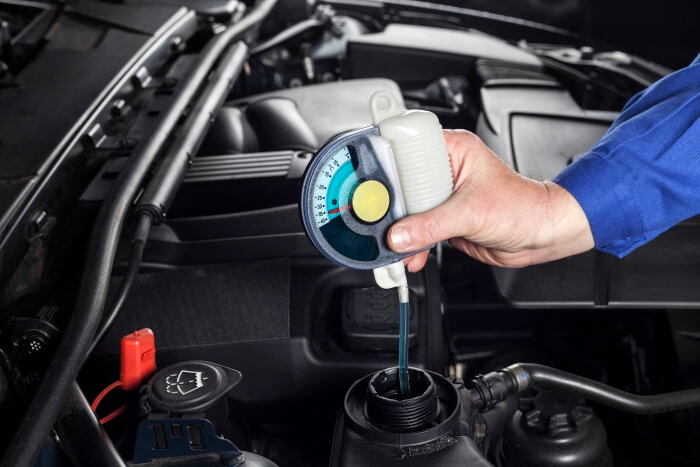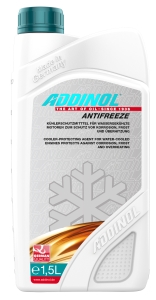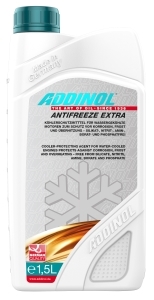


Antifreeze from ADDINOL - Cooler protection agents
Antifreeze agents for cars prevent the freezing of the coolant in the car and thus ensure that the engine functions optimally even at very low temperatures. The coolants of ADDINOL are based on ethylene glycols. As a mixture, these lower the freezing point of other liquids such as water. Additives such as corrosion inhibitors give the antifreeze further properties and protect the cooling system from corrosion and rust. In addition, they ensure effective heat exchange. Further requirements for a good coolant are: Neutrality towards rubber and plastics, low foaming tendency and high chemical stability.
The products of the ANTIFREEZE range are offered as a concentrate which can be mixed with water. Frost protection can be adjusted as required. However, the proportion of antifreeze must not be less than 33%, otherwise the corrosion protection properties are no longer existent. The products are suitable for passenger cars, commercial vehicles, construction machinery and agricultural equipment.
Our cooler protection agents
ADDINOL ANTIFREEZE
Specifications / Approvals:
ASTM D 3306, BS 6580, BS 5117, ASTM D 1121, ASTM D 1177, ASTM D 4052
ADDINOL ANTIFREEZE SUPER
Specifications / Approvals:
ASTM D 3306, BS 6580, ASTM D 4656, ASTM D 4985, SAE J 1034
Meets requirements:
MB 325.0, Porsche TL 774-C, Fiat-Iveco, MB 325.2, VW TL-VW 774 C (G11), BMW GS 94000, MAN 324 NF, MTU MTL 5048, GM QL 130100, Saab 6901 599, Cummins 85T8-2, Lada TTM VAZ 1.97.717-97, NATO code S-759
ADDINOL ANTIFREEZE EXTRA
Specifications / Approvals:
ASTM D 3306, MAN 324 SNF, ASTM D 4985, SAE J 1034, NATO-Code S-759, Ö-Norm V5123, MWM (Deutz Power Systems) 0199-99-2091, GE Jenbacher TA 1000-0200, ASTM D 6210
Meets the requirements:
MB 325.3, VW TL-VW 774 D (G12), VW TL-VW 774 F (G12+), Ford WSS-M97B44-D, MTU MTL 5048, Deutz 0199-99-1115, DDC Power Cool Plus, GM 6277 M, Wärtsilä 32-9011, John Deere JDM H5, Komatsu KES 07.892, Liebherr MD1-36-130, Volvo VCS 418-0001, Yanmar Antifreeze, DAF 74002, Mazda, Isuzu, Cummins CES 14603
Information about antifreeze agents
Mixing antifreeze agents
Antifreeze agents are divided into silicate-containing and silicate-free liquids. These must not be mixed with each other, as chemical reactions may occur. This leads, among other things, to poorer corrosion protection and poorer lubrication of the cooling water pump. In addition, the OEMs specify whether the coolant may contain silicate or not. Silicate-containing antifreeze agents run under the designation G11. Inorganic and organic substances contained therein guarantee good corrosion protection. They are used in BMW or Mercedes-Benz engines. Silicate-free antifreeze agents are prescribed for aluminium engines or radiators. Organic salts provide the best corrosion protection. Ford and Opel, for example, rely on this technology. Silicate-free coolants are classified under G12+. An exception are the classes G12++ and G13. They combine the properties of silicate-free and silicate-containing antifreeze agents. This also ensures excellent corrosion protection. Models of the VW brand use these antifreeze agents.
By the way, it doesn't matter what colour the coolants are. This does not show whether the liquids contain silicate or are silicate-free. Pay attention to the OEM specifications of the car and the respective approvals of the antifreeze. If both coolants are approved for a passenger car, they can easily be combined, regardless of whether they differ in colour. The ADDINOL products can also be mixed with coolants of the same base.
Refilling of coolants
If the level in the expansion tank is too low for your coolant, you can top up the coolant yourself. Pay attention to the manufacturer's approvals of your vehicle and the correct mixing ratio of the concentrate. Only top up as much antifreeze as necessary to level the filling quantity between the minimum and maximum mark on the expansion tank.
If you notice that the coolant level is too low and you do not have any concentrate at hand, you can fill the expansion tank with water first. In the best case, fill in distilled water, but if necessary, tap water can also be used to prevent the engine from overheating. Restore the correct ratio between water and coolant as soon as possible.
If the coolant level is too low, this indicates a defect or leak in the cooling system. Have the problem checked by a specialist workshop.

Check frost protection agent
No car runs without sufficient radiator protection. You should therefore regularly check the level at the expansion tank and readjust it if necessary. If the engine runs permanently too hot, expensive engine damage can occur.
You should check the level of the coolant once a month and the frost protection twice a year. Always carry out the check with the engine cold and switched off. If you open the lid of the expansion tank under operating conditions, the hot liquid under pressure may splash out and scalding you.
The antifreeze properties of your coolant can be checked by means of a test spindle. To do this, hold the spindle in the cooling water. The current frost protection can then be read off as a temperature. In Central Europe, frost protection should be provided down to at least -20 °C, otherwise you should increase the concentration of the frost protection agent.

Change coolant
Coolant change intervals in passenger cars are 50,000 kilometres. An exchange every three years is also recommended by many experts. Bubbles (cavitation) form in the old coolant and can explode. This causes damage to the cooling system. Follow the operating instructions for your vehicle and do not postpone the change.
Dispose of antifreeze agent
Antifreeze agents are toxic substances that can damage the environment. They are classified as hazardous waste. Do not simply pour the old antifreeze onto the floor or into the spout. If you change the radiator protection agent yourself, collect the liquid in a shatterproof container. You can then return the old coolant to the seller, return it to a recycling centre or take it to your trusted garage. There, the antifreeze is disposed of professionally and in an environmentally friendly manner.



